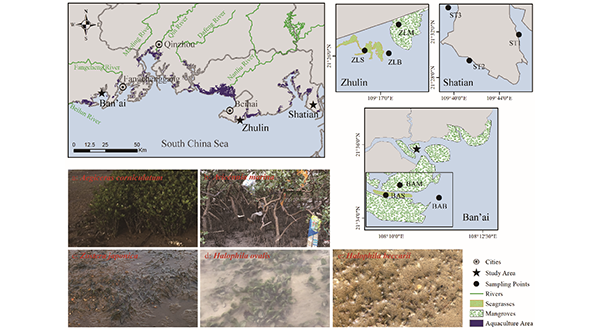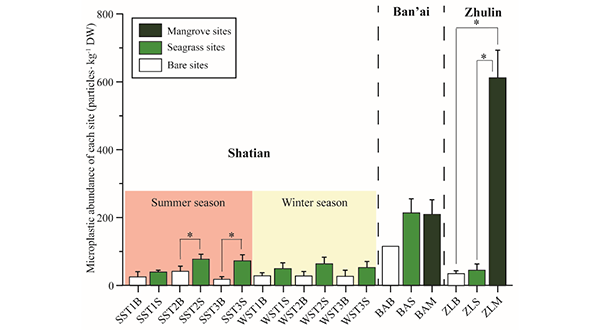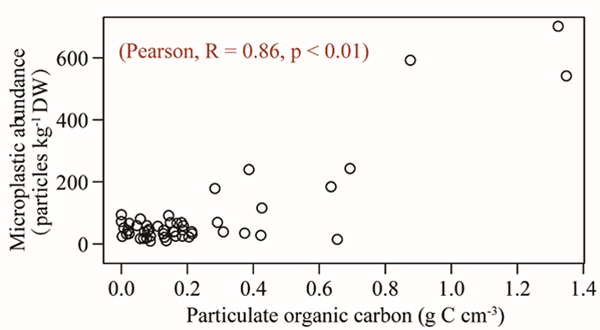NEWS
Zhejiang University Ocean College has made new progress in blue carbon ecosystem research
The coastal blue carbon research team of Associate Professor Xiao Xi from the Ocean College has made new progress in the capture of microplastic particles in the environment by the blue carbon ecosystem. The academic paper entitled New Insights into the Microplastic Enrichment in the Blue Carbon Ecosystem: Evidence from Seagrass Meadows and Mangrove Forests in Coastal South China Sea “ was published in “Environmental Science & Technology, which is an important academic journal in the field of Marine Chemistry and Environment.

Due to the excessive use of plastic products on a global scale, a large amount of plastic garbage has accumulated in the ocean, which seriously affects the health and development of marine life. Microplastic particles have become an emerging pollutant that has attracted much attention in the marine environment in recent years. The fate of microplastics in the ocean has also become a research hotspot. Blue carbon ecosystems (such as seagrass beds, mangroves, salt marshes, seaweed fields, etc.) can trap and store a large amount organic carbon in the sediment, which can mitigate climate change. And it is of great significance to carbon neutrality goal in China. However, the capacity and mechanism of microplastic enrichment by blue carbon ecosystems are not clear yet.

The blue carbon research team of the Ocean College, together with the University of Southern Denmark, the Guangxi Mangrove Research Center, and the Nanjing Institute of Environmental Sciences of the Ministry of Ecology and Environment, collected sediment samples in mangrove forests (dominated by Aegiceras corniculatum and Avicennia marina), seagrass beds (dominated by Zostera japonica, Halophila ovalis and Halophila beccarii ) and unvegetated beaches in Ban’ai, Zhulin and Shatian of Guangxi province. And at the same time, microplastic abundance and sediment properties, and particulate organic carbon content were measured.

Figure 1. Map of sampling sites in the coasts of South China Sea and representative blue carbon ecosystems
The study found that microplastics were observed in the sediments of mangroves and seagrass beds. The abundance of microplastics in the three areas ranged from 17.68 ± 8.10 to 611.75 ± 81.52 particles per kilogram of dry weight sediment. The capacity of trapping microplastics by mangroves was much higher than seagrass beds. Among them, a seagrass bed dominated by Halophila beccarii can accumulate microplastics as high as 1.9 and 4.1 times compared to unvegetated sites, while mangrove of Avicennia marina was even 17.6 times. Compared to the unvegetated sites, the seagrass bed dominated by Halophila beccarii can trap more diverse microplastics in color and size.
The abundance of microplastics in the sediment was significantly correlated with the content of particulate organic carbon, with a correlation coefficient of 0.86. This study reveals for the first time the relevance of microplastics and particulate organic carbon accumulation, which may suggest a similar environmental behavior in the blue carbon ecosystem. The high exposure risk of microplastic pollution may pose a threat to the diverse organisms living in the blue carbon ecosystem.

Figure 2 Microplastic abundance of sediments in the bare and vegetated sites. * indicate statistic significance between bare and vegetated sites.

Figure 3 Correlation between sediment particulate orgainc carbon content and microplastic abundance at all study sites in the coast of South China Sea.
The 2018 PhD student Yuzhou Huang from Ocean College, is the first author, and Associate Professor Xiao Xi is the corresponding author; and Professor Marianne Holmer, PhD student Kokoette Effiong, Caicai Xu, Jing Hu and Dr. Zhinan Su from the Guangxi Mangrove Research Center, and Dr. Shaojun Jiao from the Nanjing Institute of Environmental Sciences of the Ministry of Ecology and Environment are the co-authors of the paper. This research was supported by the National Natural Science Foundation of China, the Fundamental Research Funds for the Central Universities.
(Yuzhou Huang)

